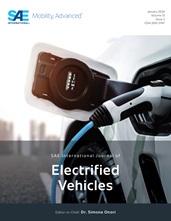A Method for Battery Sizing in Parallel P <sub>4</sub> Mild Hybrid Electric Vehicles
- Features
- Content
- This article deals with a sensitivity analysis concerning the influence that the capacity of the battery in a parallel hybrid powertrain has on the vehicle’s energy regeneration. The architecture under analysis is constituted by an internal combustion engine (ICE), which provides traction to the front axle’s wheels, and an electric motor powering the rear wheels. The energy management system (EMS) is based on a simple torque split strategy that distributes the driver’s required torque between the front and rear machines as a function of battery and electric motor functional limitations (state of charge, temperatures, and maximum admissible currents). Together with the selected driving cycles, the central role played by the battery size in the overall vehicle recoverable energy is evaluated, while the influence of the powertrain limitations is highlighted, accounting both for uncertain parameters (e.g., initial state of charge [SoC 0]) and for tunable parameters (e.g., maximum electric traction vehicle speed). Therefore, a method of sizing the battery of a P4 mild hybrid electric vehicle (HEV), which allows the maximization of the braking energy recovery, is developed.
- Pages
- 15
- Citation
- Castellazzi, L., Ruzimov, S., Bonfitto, A., Tonoli, A. et al., "A Method for Battery Sizing in Parallel P 4 Mild Hybrid Electric Vehicles," SAE Int. J. Elec. Veh. 11(1):97-111, 2022, https://doi.org/10.4271/14-11-01-0008.
